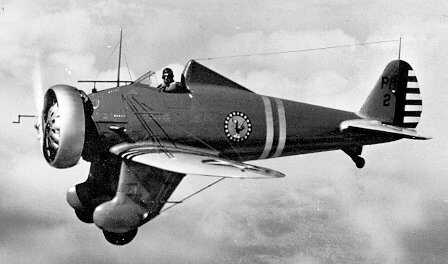American Counterattacks December 7
Three American formations are in route toward where the Japanese fleet is assumed to be. The Army aircraft are well in the lead, but also are of on their heading and are forced to do a box search. Thus the Marine Dauntless dive bombers arrive at 845 Hours. The Japanese have 36 fighters up as a combat air patrol and they swarm all over the Marine aircraft, shooting 17 of them down and only 5 manage to make a combat dive, where 2 are blasted apart by Japanese flak. Only 3 manage to drop their bombs, and all three miss the Kaga, the biggest target in the Japanese fleet. One is then caught escaping by the Zeros and both survivors escape but only one makes it back to Oahu where it lands at Haleiwa, while the other ditches on the way home. Only 1 Marine of the 44 who took part in the attack survives, the pilot who made it to Haleiwa, and his gunner is dead in the seat behind him. His aircraft is a write off.
A B17 spots the Japanese fleet next at 0907 hours, and makes an attack after providing a position report. It too is spotted by the Japanese CAP, and the Japanese learn that the B17 is a very tough aircraft, as while it is shot to pieces it manages to escape where it ends up making an acceptable landing at Wheeler Field (in that everyone survives the landing) but the wreckage is pushed off the runway. By a miracle all of the crew survives although only two remain unwounded (the pilot and the flight engineer). Their bombing attack is a failure however, as three bombs land in the water well to the starboard of the Kirishima. The crew claims two hits on a battleship and that it was sinking, as flames and flashes were very visible from the Japanese ship.
However, the position report is picked by by the A20s, who are about to return home, and the Vindicators, who are approaching the Japanese fleet as well. The Army bombers come in at 300 miles an hour in a shallow dive and pick the first carrier they see, the Akagi at 0918 hours. The Army bombers are far faster than the Japanese expect, and the Japanese fighters only have a 30 mile an hour speed advantage over them. Three of the fighters make the mistake of making a head on attack against the A20s, and learn the hard way that the Americans have four fixed .30 caliber machine guns forward. One is blasted apart, and the other two are damaged and forced to break off. The Japanese manage to shoot down 8 of the bombers in the air battle that follows but 5 of them manage to drop their bombs but miss their target. However, heavy strafing does cause numerous casualties aboard the Japanese ship as all 5 bombers concentrate their fire on the Akagi's island. The bridge and flag bridge are both swept by machine gun rounds and Nagumo and several of his staff are killed. The lone surviving A20, badly shot up, ditches on its return home resulting in the deaths of both crew members.
However, the 2 Marine Vindicator's reach the Japanese fleet at that moment, and they dive on the first carrier they see, the Zuikaku. With the Japanese attention firmly focused on the Army bombers, they are not even spotted until they pull out of their dives and both place their 1,000 pound bombs squarely on the flight deck of the Japanese carrier. The forward elevator is blasted into wreckage by one bomb, while the other penetrates the flight deck and explodes in the hanger below, wrecking it and starting a serious fire that destroys the spare aircraft that were being assembled and killing dozens of men. Although the fires are put out within 30 minutes, the Zuikaku is no longer available for flight operations and its aircraft are recovered by the other carriers. Both bombers escape making it into clouds before they can be swarmed by the Japanese fighters and both manage to make it home.
The Japanese finish recovering their aircraft 180 miles north north west of Oahu at 1030 hours and then begin their retirement at 24 knots heading west. Meanwhile, Major Landon and his 11 B17s arrive at Hickam Field, which is still burning when they land. Army personnel hurriedly refuel, arm and bomb up the aircraft and all 11, along with the 5 B17Ds that are available take off at 1400 hours heading for the most likely Japanese position. At 1700 hours they find the Japanese fleet, and bombing from 20,000 feet, surround the Japanese warships with splashes but score not a single hit. The Japanese fighters fail to reach altitude before the American bombers are long gone and break off the pursuit.
At 1810 hours, with dusk rapidly approaching, the American submarine S-23 is nearly run down by the Japanese fleet but manages to fire all its forward torpedo tubes at the nearest carrier, the Soryu. Of four torpedoes, three actually hit the carrier and two of them detonate. A chain reaction of explosions results and after 20 minutes it is clear that the ship is doomed. Two destroyers are left behind to take off survivors and the rest of the Japanese fleet steams on into the gathering darkness. The S-23 is attacked by Japanese destroyers for 20 minutes but escapes unscatheed. The Soryu goes down with 432 men, and takes with it all of its aircraft as well.
With that the first day of battle between the Imperial Japanese Navy and the United States Navy comes to an end.

